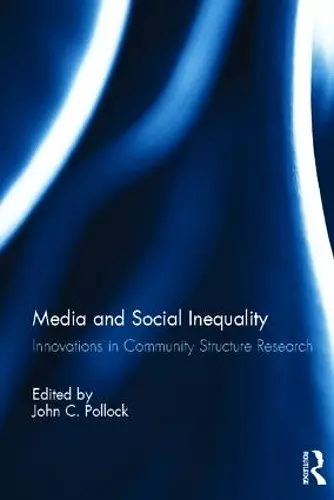Media and Social Inequality
Innovations in Community Structure Research
Format:Hardback
Publisher:Taylor & Francis Ltd
Published:18th Dec '12
Currently unavailable, and unfortunately no date known when it will be back
This hardback is available in another edition too:
- Paperback£44.99(9781138806764)

This book is among the first to systematically explore the impact of community inequality on reporting political and social change. Although most journalism scholars are still fascinated by the impact of media on society, Media and Social Inequality explores the reverse perspective: the impact of society on media. Using a 'community structure' approach, and rejecting the perspective that studies of media and audiences can be reduced to the individual level of psychological phenomena, all contributions examine connections between community-level 'macro' characteristics and variations in the coverage of critical issues. This innovative book differs from previous community structure volumes in two ways. First, contributions explore a far wider range of community characteristics by employing creative methodologies, modern archives, and databases that facilitate larger, more diverse samples; multilevel and longitudinal analyses; composite measures of both 'content' and editorial judgment; new technologies; and social network analysis. Second, a traditional emphasis on media as instruments of political and social 'control' is replaced by media as potential mirrors of social 'change,' exploring 'bottom-up' measures of 'vulnerability', 'concentrated disadvantage', and 'ethnic diversity/pluralism'. The volume contains two original chapters: one on nationwide US coverage of the "Occupy" movement in the expanded introduction, and another on nationwide US coverage of universal health care.
This book was originally published as a special issue of Mass Communication and Society.
'This book...is a study of "the impact of society on media" rather than the usual concern of media's impact on society; it also makes use of Big Data from a variety of sources that are not common in current communication research; finally, it suggests that the research on community structure not only influences what journalism says about social problems but that research from this volume can help journalists promote "social change".'Emilie G. McAnany, Communication Research Trends
'John Pollock has established a well-earned reputation as a productive scholar who believes that undergraduates can contribute to knowledge at the same time as they are learning about the role that the media of communication play in shaping and reflecting the communities in which they live...Although Media and Social Inequality was originally published as a special issue of Mass Communication and Society, Pollock's expanded introduction and an analysis of newspaper coverage of the universal health insurance mandate written by Pollock and two of his former students are original contributions to this volume.'Oscar H. Gandy Jr., Journal of Communication
'...Media and Social Inequality offers thought-provoking and diverse studies of media’s community context from an impressive lineup of community news researchers. Variation in scholars’ approaches reflects variation in the meaning of “community structure.” Some chapters are consistent with Pollock’s community structure approach, assessing the relationship between community characteristics and news coverage. Other chapters are rooted in the structural pluralism approach of Tichenor, Donohue, and Olien, which conceptualizes news as a consequence of a community’s power distribution. Chapters focus on an array of dependent variables: news content, social trust, blog creation, and neighborhood ties are all assessed as possible consequences of community structure. Findings vary, depending on conceptualization and measurement. Clearly, “community structure” has many dimensions, and a great deal of the book’s value lies in the revelation and comparison of these dimensions.'Wilson Lowrey, Journalism & Mass Communication Quarterly
ISBN: 9780415631181
Dimensions: unknown
Weight: 540g
194 pages